IT Staff Augmentation
IT staff augmentation has never been easier. No intermediary. Get your own tech team and:
- Up to 40% cost savings
- Your direct management and corporate culture
- No buy-out costs or hidden fees
- 10+ skilled engineers in 2 month; 100+ in a year
- Fully managed back-office: payroll, benefits, and more
More Than Just Tech Staff Augmentation
Classic IT Staff Augmentation Providers Can’t Match
2.5 years
average tenure of developersCultural alignment
with your company valuesPricing transparency
no hidden or buy-out feesLegal & compliance
and other needed operational supportExceptional dedication
it’s literally your own teamLong-term partnership
shared responsibility & commitmentKey Things about Tech Staff Augmentation Services
What Is IT Staff Augmentation and Why Does It Matter Strategically?
IT staff augmentation is an outsourcing approach that lets you bring in remote tech specialists while still managing them directly. These external experts work alongside your internal IT team, either temporarily or for longer periods, depending on your project needs and overall business strategy.
Usually, this model involves partnering with a staffing provider that maintains a large network of IT professionals across different domains. From there, you choose specialists with the exact skills required to close gaps in your current team.
This can mean anything from engaging a single remote developer to putting together a full cross-functional team with diverse expertise.
What Qualities Should You Look for in IT Staff Augmentation Partner?
When choosing an IT staff augmentation provider, you’ll want a partner that fits your business goals and can reliably deliver the right expertise and level of support. Here are the key traits to look for:
- Strong industry reputation: Prioritize companies with proven experience, positive reviews, and detailed case studies. A solid track record suggests they’re dependable and results-oriented.
- High-quality talent pool: Check how they source and vet specialists. They should have strict screening processes and be able to offer professionals with skills and experience that match your needs.
- Flexibility and scalability: Your partner should respond quickly when your needs change—whether that means adding more people, scaling down, or switching skill sets mid-project.
- Technical depth: Look for a provider with strong expertise in your core technologies and platforms, or one that can offer a broad range of specialists across multiple tech domains.
With these criteria, you can compare IT staff augmentation providers more confidently and choose one that genuinely supports your company’s goals.
Tech Staff Augmentation Benefits
Tech staff augmentation allows tech businesses to augment their in-house team with specific skills or software engineering experience by hiring temporary developers.
In traditional software development outsourcing, an external company manages a process or a project independently. If you hire a Tech staff augmentation company, external specialists temporarily join your team.
If you’re scaling product delivery but headcount is frozen, tech staff augmentation lets you add specialist capacity without long-term commitments. With vetted talent embedded into your team, you keep velocity while retaining your engineering culture and aligning with business goals. Many tech startups and enterprises turn to custom staff augmentation for tech companies to gain rapid access to tech experts across AI/ML, data, mobile, and cloud while protecting IP and standards. In regulated environments, staff augmentation for tech industry ensures contributors understand audits, privacy, and sector-specific controls.
Key benefits:
- Expertise. There’s no in-house expert for a short-term task? A Tech staff augmentation service provider helps access diverse tech talent upon demand.
- Flexibility. Businesses can size up and down to meet changing demands without the long-term commitment to hiring full-time employees.
- Cost-effectiveness. Businesses don’t need to maintain a large team. Instead, they can save on benefits, training, and infrastructure costs.
- Modern toolchain included. Many providers bring testing, CI/CD, and cloud-ready environments as part of their services, reducing setup time and spend; they standardize technology stack choices, frameworks, and quality gates for consistent programming and software engineering practices.
- Risk management. Use a managed capacity model from a trusted agency or company to guarantee backfills, improve retention, and stabilize delivery.
Tech Staff Augmentation Challanges
Short-lived cooperation
Remote members of your augmented team will see your product only as one out of many other projects. Expect temporary efficient performance from your talent augmentation provider, but true dedication is hard to come by.
Buy-out fees
Should you want to employ programmers in-house, your Tech staff augmentation service company will charge you a fee, sometimes reaching $20,000 per developer from an augmented team.
Management overload
Coordinating in-house employees with contractors in your augmented team presents additional challenges, such as miscommunication or corporate culture mismatch.
Data privacy issues
Beware: you’ll share sensitive data about your applications, resources, and technology with an external party. If IT team augmentation firms don’t ensure proper data security among temporary programmers, you risk data leakage.
Extended onboarding
External staff still need product context. With tech staff augmentation model – this could be a challange. Solve with a playbook: architecture maps, API catalogs, standardized local dev setup, and a 90-minute domain primer video. Include team members from core modules to accelerate pairing, and prefer developer staff augmentation for streams that benefit from embedded senior mentorship.
Knowledge retention
Rotate internal maintainers through augmented pods, require ADRs (architecture decision records), and finish with a structured offboarding. Pair engineering staff augmentation with shared docs, demos, and ownership handoffs to limit drift.
IT Staff Augmentation Market Trends for 2026
Focus on advanced skills
Demand for AI platform work, data pipelines, IPA, cloud FinOps, and secure-by-design patterns continues to surge; IT leaders want contributors fluent in observability, privacy, and cost controls within the technology stack.
Staffing automation
Providers now triage candidates with skill assessments, coding tasks, and interview analytics, accelerating match time and raising the signal-to-noise for it staffing decisions.
Global market access
Companies mix nearshoring with offshoring to reach deeper pools while maintaining overlap for critical ceremonies, using playbooks that travel well across markets and sectors.
Continued growth
Budgets are intact but under scrutiny; organizations are shifting from fixed teams to elastic ones that blend permanent and augmented contributors through tech talent staff augmentation.
Best Locations for IT Staff Augmentation
The best offshore and nearshore locations combine skilled talent, tech market growth, and cost-effectiveness. These are:
1. Latin America:
- 2M software developers known for solid expertise in AI, mobile development, fintech, cloud, and e-commerce sectors and Java, JavaScript, Python, and C++ languages;
- 49% lower salaries than in the US;
- Up to 60% lower taxes than in the US;
- Latin America’s IT services revenue is forecast to rise from about US $55 billion in 2025 to nearly US $67 billion by 2030, equating to an average annual growth rate of roughly 4.1%.
2. Eastern Europe:
- 1.8M software developers renowned for top-tier skills in AI, Blockchain, IoT, Cloud sectors, and C#, Java, Python, SQL, PHP, and JavaScript languages;
- 44% lower salaries than in the US;
- Reduced tax burden: from 10% to 23% on personal and corporate income;
- From 2020 to 2024, the EE IT Services market surged from $9.9 billion to $14.3 billion, representing a 9.7% growth rate.
- From 2025 to 2030, Eastern Europe’s IT services market is projected to expand from roughly US $15 billion to US $18 billion, reflecting a steady 3.9% CAGR.
IT Staff Augmentation:Common Team Roles
Here’s an overview of roles that are most often covered through IT staff augmentation services:
- Software developers: Brought in to build new features, extend existing products, or modernize legacy applications.
- Mobile application developers: Build and refine apps for iOS, Android, or cross-platform frameworks to support mobile product strategies.
- QA analysts: Test software to catch bugs early, improve usability, and ensure products are stable before going live
- Web designers and web developers: Combine creative and technical skills to launch or refresh a company’s website and overall online presence.
- IT support specialists: Keep systems running, troubleshoot technical issues, and make sure the IT infrastructure performs reliably.
- Network engineers: Design, configure, and maintain networks so data can move securely and efficiently inside and outside the organization.
- Data scientists and analysts: Turn raw data into insights that support strategic decisions and help companies understand trends and performance.
- Cybersecurity experts: Identify and close security gaps, monitor threats, and protect systems and data from cyberattacks.
- Cloud computing specialists: Plan, manage, and optimize cloud environments as businesses migrate workloads and services to the cloud.
Tech Staff Augmentation Services Pricing (Current Pattern)
If you are choosing between LATAM and Eastern Europe, expect senior monthly totals (contractor basis) to vary by role and city tier. Typical 2025 patterns we see:
- Full-Stack & Python: similar mid-range in Poland/Romania and Mexico/Colombia, with Ukraine and Argentina often slightly lower on average for contractor engagements.
- Mobile & DevOps developer roles: premium over full-stack in both regions due to supply constraints.
- AI engineers: widest spread by country and by project complexity (research vs. productization).
Ask providers for transparent rate cards, currency hedging, and PEPM breakdowns that include benefits, local taxes, bench coverage, and any managed services add-ons.
Types of Tech Staff Augmentation Providers
Traditional staffing providers
Generalist agency coverage for non-critical tasks where breadth beats depth.Its primary function is to augment your team with the needed expertise in non-critical projects but not the employees with specific skill sets. For example, if you’re the CEO of an IT product company, you may use the services of such staffing vendors to find a good data entry specialist.
Boutique staffing firms
Smaller, expert teams that can secure rare profiles (e.g., Principal Architect) with hands-on search and tighter collaboration—often at a higher price point.
Staffing platforms (“human clouds”)
Marketplaces that connect you to curated and vetted talent; on-demand models may include trial sprints and rapid scaling up/down—ideal for tech talent staff augmentation services when time-to-start matters.
Software R&D center model
Instead of ongoing augmentation, you stand up your own entity-lite hub with dedicated programmers plus legal, payroll, office, and IT operations provided by the provider—useful for longer horizons and retention.
How the R&D center path plays out: Real Example
People.ai, U.S. product company expanding to Eastern Europe engaged a partner to recruit 25 programmers across back end, data, and QA. Within four weeks they launched a branded R&D hub with payroll, compliance, and IT secured. The augmented pod evolved into a stable team over the next two quarters, reducing turnover risk and improving roadmap ownership while complementing tech talent staff augmentation for burst capacity.
What are the Top 10 IT Staff Augmentation Service Providers for 2026?
- Alcor – Specializes in building and scaling dedicated engineering teams and R&D centers for product tech companies in Eastern Europe and Latin America, combining deep tech recruitment with EOR and full operational support.
- Toptal – Global network known for its highly selective vetting (often marketed as the “top 3%” of freelance talent) across software development, design, and product roles.
- Turing – AI-driven staff augmentation platform that matches companies with pre-vetted senior developers in 100+ countries.
- Andela – Connects companies with top engineers (initially from Africa, now global), focusing on long-term remote engineering teams.
- BairesDev – Nearshore partner from Latin America, widely cited for large, scalable developer teams for US and global clients.
- N-iX – Eastern European provider offering dedicated development teams and complex enterprise solutions, especially in banking, telecom, and fintech.
- Devox – Offers IT staff augmentation with strong capabilities in web and mobile development, DevOps, and QA for verticals like fintech and healthcare.
- DistantJob – Remote-first tech recruitment and augmentation company focused on long-term, culturally aligned distributed teams.
- eSparkBiz – Indian-headquartered provider delivering augmented teams across web, cloud, AI/data analytics, and enterprise solutions.
- Cognizant – Large global IT services firm that also provides enterprise-grade staff augmentation, especially for Fortune-500-level clients.
How We Raise Standards for Tech Staff Augmentation Services
If your vision is long-term and your strategy is to scale, then Tech staff augmentation won’t give you the carte blanche.
Alcor’s all-in-one software R&D accelerator will help you step up the game with Silicon Valley-caliber talent. Our team of 40 experienced recruiters provides expeditious tech recruitment, while our legal and account teams are in charge of Employer-of-Record services and full operational support. In one year, you’ll get a tech R&D center from 0 to 100 software engineers.
With Alcor’s help, product tech companies scale into 8 key locations in LATAM or Eastern Europe with superior tech teams, employer branding support, and full-fledged and legally backed-up R&D offices.
Why Tech Companies Migrate
from Staff Augmentation Providers to Alcor?
- Right talent from the right markets Your requirements and individual vetting, access to the optimal candidates, free replacements
- People as a strategic asset Grow, invest, and retain tech talent. Build trust, boost performance, and benefit from long-term relationships
- Your team Complete transparency and control over your remote team, no go-between, only your culture and rules
- Transparent costs, predictable for years Set and revise individual compensations, understand every dime & get contractual volume discounts
- No exit barriers No exit fees, immediate and free IP transfer, audited and proven by publicly-traded companies
Staff Augmentation
- Entry-level talent, seniority inflation Wrong seniority mix, ungrounded titles, bench-focused project staffing
- No capitalization on knowledge Little/no control over engineers’ allocation, sudden moves to other clients
- Not your team Black box approach in compensation, motivation, performance, and individual contribution
- Untransparent & ever-rising costs Tricky rate cards or expensive pricing wrappers, regular cost increase with no visible returns
- Fence-based business Ridiculous notice periods and exit fees, legal obstacles to insourcing key contributors, and retaining knowledge
Tech Talent Salaries Across All Stacks
Get precise estimations according to your JDs.
Estimate my team costWe Can Hire Any Developer
Hire and Retain Tech Staff Hassle-Free
Alcor provides all-in-one staffing and managment solution for your remote team
- From 0 to 100+ engineers in one key talent pool
- Employer of record – no entity compliant employment
- Comprehensive in-country support
- No buyout or other hidden fees
- Your team from day one. Your management. Your culture.
Companies Scaling with Alcor








Alcor is a reliable partner that meets our hiring needs. We finally hired experienced software engineers in Eastern Europe with strong tech skills and business acumen. Account Managers are awesome!
With Alcor’s all-in-one solution, we got a software R&D office with 15 senior PHP devs and a compliant operational coverage. I really appreciated their transparent pricing structure and deep expertise.
We interviewed a lot of EoR platforms and companies, but Alcor was the only one that provides a combo package of EoR and Recruting offerings. Alcor helped us build a full stack team in 1.5 month.
We wanted to switch from our outsourcing provider, and Alcor has become really game-changing for us. Within a mere 6 months, we got a fully-fledged team of 30 engineers in our own R&D office.
Alcor’s R&D solution eclipses full-cycle recruitment, EOR service, and operational support for our offshore team. Their ‘all-in-one place’ approach is far more cost-effective than I could’ve imagined.
I value their commitment to going the extra mile. We evolved from an outstaff project into an independent company, and Alcor’s support was crucial. They hired and ondoarded 15+ professionals for us.
Thanks to Alcor, we hired four engineers and a designer that strengthened our team. Beside stellar recruitment, Alcor flawlessly handled our payroll. Their approach was seamless and swift.
Alcor closed our 4 QA positions in a month and more than doubled the team in a year! We chose Alcor because of their communication style, cost, scope of services, and ideas to help us be successful.
Expanding our engineering team outside the US with Alcor was a game-changer! They found 15 talented developers and provided seamless EOR & operational support. Great responsiveness to our needs!
Alcor’s flexible model helped us scale from 0 to 30 devs in a year first, and then to 50! No buy-out fees, seamless hiring, and top-tier talent. A hassle-free way to grow without setting up a subsidiary!
Alcor helped us hire the top 5% of tech talent while building our employer brand. They were proactive, never compromised on quality, and delivered. Three years later, our hires are still thriving!
FAQ About IT Staff Augmentation
When should a company choose Tech staff augmentation?
Staff augmentation for Tech works like a charm when you need talent augmentation with unique expertise and hit your project deadlines. However, if you’re looking for long-term cooperation with IT team augmentation provider, this staffing solution may fall short due to a lack of dedication on the developers’ part, as well as communication and management.
Does Alcor provide Tech staff augmentation services?
Alcor isn’t a Tech staff augmentation agency—we’re dedicated to helping tech product companies scale from 0 to 100 Silicon Valley-caliber engineers in a year at up to 40% cost savings compared to traditional tech outsourcing models. With our blend of tech recruitment and Employer of Record, we equip you with senior, lead, and C-level tech talent and comprehensive HR & legal support to establish your own software development office overseas.
How is Alcor better than Tech staff augmentation services?
We hire Silicon Valley-caliber professionals, so you get better talent for the exact cost if compared to outsourcing. Unlike Tech staff augmentation service companies, we let you fully control your team from day one, with seamless integration and no buy-out fees. Best of all, our solution is built to last: developers we hire stay an average of 2.5 years.
What is the average level of experience of Tech developers Alcor hires?
Alcor’s 40 recruiters specialize in finding senior, lead, and C-level developers. With our 253,000+ database of pre-vetted candidates, we target the top 10% of the market, particularly those with a rare tech stack and on top of Agile best practices.
Can you recruit C-level Tech experts?
Yes, Alcor has successfully recruited a Director of Engineering for Dotmatics and filled key roles that serve as stepping stones to C-level management positions. For instance, we swiftly found a Product Manager for GoTransverse and QA Leads for Tonic Health and Ledger. On average, it takes just 8 CVs for us to secure an offer, and this level of performance applies to C-level Tech roles as well.
How should a Tech staff augmentation team provider handle intellectual property security risks?
Tech staff augmentation services presuppose sharing your intellectual property with third-party software engineers. Unless they are officially part of your team, it is impossible to avoid the risk entirely. You can draw up a non-disclosure legal agreement with your Tech staff augmentation provider to enhance data protection or else—consider a business model alternative to IT team augmentation.
Does Alcor protect intellectual property within the tech R&D center model?
Alcor fully integrates the hires into our client’s existing team and leaves decision-making to them. This way, our R&D center model provides the highest possible IP security. For example, it worked seamlessly for People.ai: they got a 100% integrated team and secured IP rights to the fullest extent.
How is the staff augmentation approach transformed within a software R&D center?
Think of an upgraded Tech staff augmentation service plus managed services as operational support, EoR, and legal assistance. Then, subtract markups, buy-out fees, and third parties in your business. Alcor’s solutions focus on senior talent, transparent communication, and a full package of services to help you launch your own R&D office in LATAM or EE.

















